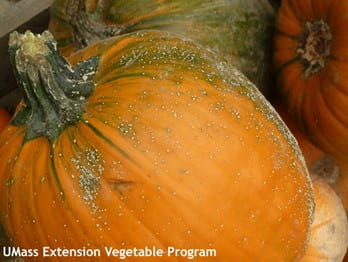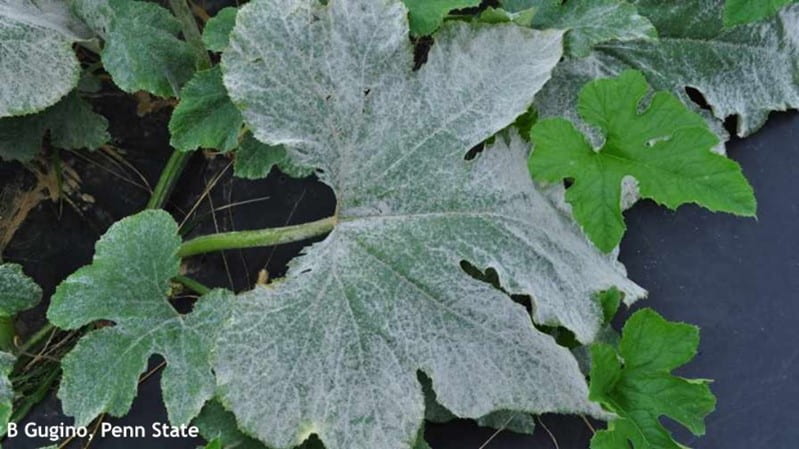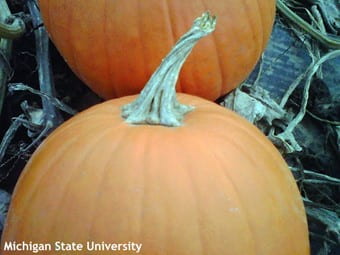Gordon Johnson, Extension Vegetable & Fruit Specialist; gcjohn@udel.edu
I was recently asked about disease control programs for pumpkins. The following was modified from an article by Dr. Kate Everts in 2019 that I have added updated fungicide recommendations and additional information about certain diseases.
A frequent question that I get from growers is “what is the best spray program for my pumpkin crop (and other ornamental squashes)?”. It is a challenging question to answer, in part because each field/farm may have different disease pressure, and Ag Chem suppliers may only stock some fungicides. With that in mind, I have come up with the following step by step procedure to use as a guide in designing an individualized pumpkin program. The numbers in parenthesis that follow the fungicide name are the Fungicide Resistance Action Committee (FRAC) code for the product. Except for the broad- spectrum fungicides chlorothalonil, mancozeb and copper, always alternate other fungicides with different FRAC codes to avoid disease resistance buildup.
Step 1
Use all available cultural practices to reduce disease pressure, including planting disease resistant varieties when possible, using good rotations, and using no-till mulch based systems. If possible, modify your spray equipment to get excellent fungicide coverage on both the upper and lower surfaces of leaves.
Step 2
Learn to identify key diseases: powdery mildew, downy mildew, Plectosporium blight, gummy stem blight/black rot and bacterial leaf spot.
Step 3
Begin a basic preventative spray program with a chlorothalonil or mancozeb product. Spray every 7 to 14 days, beginning when vines run. (Organic alternative: copper). This will give protection against most foliar diseases.
Step 4
Use predictive models or scout for disease presence and if the following diseases occur or are predicted, use the following guidelines:
Gummy Stem Blight/Black Rot and Anthracnose
Alternate chlorothalonil with Rally (3), tebuconazole (3), Procure (3), Proline (3), Rhyme (3), Inspire Super (3+9), Aprovia Top (3+7), Switch (9+12), or Miravis Prime (7+12).
Bacterial Leaf Spot
Add a copper product to the basic preventative program (applied every 7 to 10 days).
Powdery Mildew
Powdery mildew control is critical to maintain quality of pumpkins and maintain strong “handles”. Some varieties have resistance or tolerance to powdery mildew and should be used when possible. Powdery mildew generally occurs from mid-July until the end of the season. Development on tolerant varieties will vary from year to year. Planting tolerant varieties will help delay the development of powdery mildew and improve the performance of fungicides.
Make first application when powdery mildew is observed in the area or is detected by scouting (one lesion on the underside of 45 old leaves per acre). Add powdery mildew specific products to basic preventative program. Alternate FRAC codes.
Select one of these: Vivando (50), Luna Experience (3+7), Torino (U06), or Quintec (13).
And alternate with one of the following: Rally (3), tebuconazole (3), Proline (3), Rhyme (3), Inspire Super (3+9), Luna Experience (3+7), Aprovia Top (3+7), Magister(39), Miravis Prime (7+12) or Pristine (7+11).
(Organic alternative: Regalia, Micronized Wettable Sulfur)
- Powdery mildew on pumpkin leaves.
- Shriveled pumpkin handles are common with powdery mildew infections.
Downy Mildew
Only apply if the disease is predicted in the region. Strains of downy mildew that infect cucumbers and cantaloupe may not affect pumpkins and winter squash. If found in the region, add downy mildew specific product to the basic preventative program. Select two downy mildew products with different FRAC codes and alternate them. Downy mildew products include: Orondis Ultra (U15+40), Orondis Opti (M5+U15), Ranman (21), Previcur Flex (28), Presidio (43), Elumin (22), Zing! ((M5+22), Ariston (M5+27), Tanos (11+27), Curzate (27), Forum (40), and Zampro (40+45).
Plectosporium Blight
Chlorothalonil is good on Plectosporium blight. Full coverage will be needed for control.

Plectosporium lesions on pumpkin fruit.
Step 5
Special cases:
Phytophthora Fruit Rot.
Avoid planting pumpkins in a field with a history of this disease. To manage Phytophthora fruit rot, select two of the following Phytophthora products that are in different FRAC code groups and rotate them. Phytophthora fruit rot products include Orondis Ultra (U15+40), Orondis Opti (M5+U15), Ranman (21), Presidio (43), Elumin (22), Zing! ((M5+22), Forum (40), and Zampro (40+45).
Fusarium Fruit Rot
This disease is especially destructive in fields where pumpkins are grown every year. Once the pathogen is established in a field, loss can be significant. Fruit rot is caused by several Fusarium spp., and fungicide applications are not effective. Hard rind cultivars are less susceptible to Fusarium fruit rot than other cultivars. Production of pumpkin on a no-till cover crop mulch layer such as winter rye plus hairy vetch has been shown to help reduce disease incidence. Greater disease reductions will occur when the mulch layer is thicker.
Viruses (WMV, PRSV, ZYMV, and CMV)
The most prevalent virus in the mid-Atlantic region is WMV, followed by PRSV, ZYMV, and CMV. For control use varieties with virus resistance whenever possible. Reduce aphid transmission of viruses with insecticide programs.
This information was adapted from https://sites.udel.edu/weeklycropupdate/?p=14260 by Kate Everts, Vegetable Pathologist, University of Maryland and the MidAtlantic Commercial Vegetable Production Recommendations: https://www.udel.edu/content/dam/udelImages/canr/photography/extension/sustainable-ag/NFP-2020-F-Pumpkin.pdf


